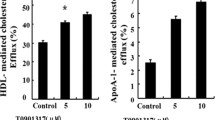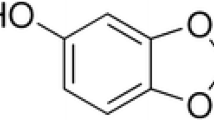Abstract
Trans fatty acid consumption is associated with an increased risk of coronary heart disease. This increased risk has been attributed to decreased levels of HDL cholesterol and increased levels of LDL cholesterol. However, the mechanism by which trans fatty acid modulates cholesterol transit remains poorly defined. ATP-binding cassette transporter A1 (ABCA1)-mediated macrophage cholesterol efflux is the rate-limiting step initiating apolipoprotein A-I lipidation. In this study, elaidic acid, the most abundant trans fatty acid in partially hydrogenated vegetable oil, was shown to stabilize macrophage ABCA1 protein levels in comparison to that of its cis fatty acid isomer, oleic acid. The mechanism responsible for the disparate effects of oleic and elaidic acid on ABCA1 levels was through accelerated ABCA1 protein degradation in cells treated with oleic acid. In contrast, no apparent differences were observed in ABCA1 mRNA levels, and only minor changes were observed in Liver X receptor/Retinoic X receptor promoter activity in cells treated with elaidic and oleic acid. Efflux of both tracers and cholesterol mass revealed that elaidic acid slightly increased ABCA1-mediated cholesterol efflux, while oleic acid led to decreased ABCA1-mediated efflux. In conclusion, these studies show that cis and trans structural differences in 18 carbon n-9 monoenoic fatty acids variably impact cholesterol efflux through disparate effects on ABCA1 protein degradation.







Similar content being viewed by others
Abbreviations
- ESI:
-
Electrospray ionization
- MS:
-
Mass spectrometry
- CE:
-
Cholesteryl esters
- LXR:
-
Liver X receptor
- RXR:
-
Retinoic X receptor
- RCT:
-
Reverse cholesterol transport
- ATP:
-
Binding cassette transporter A1- ABCA1
- apoA-I:
-
Apolipoprotein A-I
References:
Micha R, Mozaffarian D (2009) Trans fatty acids: effects on metabolic syndrome, heart disease and diabetes. Nat Rev Endocrinol 5:335–344
Mozaffarian D, Katan MB, Ascherio A, Stampfer MJ, Willett WC (2006) trans fatty acids and cardiovascular disease. N Engl J Med 354:1601–1613
Mensink RP, Katan MB (1990) Effect of dietary trans fatty acids on high-density and low-density lipoprotein cholesterol levels in healthy subjects. N Engl J Med 323:439–445
Stampfer MJ, Sacks FM, Salvini S, Willett WC, Hennekens CH (1991) A prospective study of cholesterol, apolipoproteins, and the risk of myocardial infarction. N Engl J Med 325:373–381
Yang Y, Jiang Y, Wang Y, An W (2010) Suppression of ABCA1 by unsaturated fatty acids leads to lipid accumulation in HepG2 cells. Biochimie 92:958–963
Assmann G, Gotto AM, Jr. (2004) HDL cholesterol and protective factors in atherosclerosis. Circulation 109: III8–14
Cuchel M, Rader DJ (2006) Macrophage reverse cholesterol transport: key to the regression of atherosclerosis? Circulation 113:2548–2555
Glass CK, Witztum JL (2001) Atherosclerosis: the road ahead. Cell 104:503–516
Nofer JR, Kehrel B, Fobker M, Levkau B, Assmann G, von Eckardstein A (2002) HDL and arteriosclerosis: beyond reverse cholesterol transport. Atherosclerosis 161:1–16
Rader DJ, Alexander ET, Weibel GL, Billheimer J, Rothblat GH (2009) The role of reverse cholesterol transport in animals and humans and relationship to atherosclerosis. J Lipid Res 50(Suppl):S189–S194
Attie AD, Kastelein JP, Hayden MR (2001) Pivotal role of ABCA1 in reverse cholesterol transport influencing HDL levels and susceptibility to atherosclerosis. J Lipid Res 42:1717–1726
Malik P, Berisha SZ, Santore J, Agatisa-Boyle C, Brubaker G, Smith JD (2011) Zymosan-mediated inflammation impairs in vivo reverse cholesterol transport. J Lipid Res 52:951–957
Rader DJ (2006) Molecular regulation of HDL metabolism and function: implications for novel therapies. J Clin Invest 116:3090–3100
Rosenson RS, Brewer HB Jr, Davidson WS, Fayad ZA, Fuster V, Goldstein J, Hellerstein M, Jiang XC, Phillips MC, Rader DJ, Remaley AT, Rothblat GH, Tall AR, Yvan-Charvet L (2012) Cholesterol efflux and atheroprotection: advancing the concept of reverse cholesterol transport. Circulation 125:1905–1919
Wang Y, Oram JF (2007) Unsaturated fatty acids phosphorylate and destabilize ABCA1 through a protein kinase C delta pathway. J Lipid Res 48:1062–1068
Listenberger LL, Ory DS, Schaffer JE (2001) Palmitate-induced apoptosis can occur through a ceramide-independent pathway. J Biol Chem 276:14890–14895
Bailey JM (1965) Lipid metabolism in cultured cells. Iv. serum alpha globulins and cellular cholesterol exchange. Exp Cell Res 37:175–182
Brown MS, Goldstein JL, Krieger M, Ho YK, Anderson RG (1979) Reversible accumulation of cholesteryl esters in macrophages incubated with acetylated lipoproteins. J Cell Biol 82:597–613
Henriksen T, Evensen SA, Blomhoff JP, Torsvik H, Carlander B (1979) The effect of serum lipoproteins on cholesterol content and sterol exchange in cultured human endothelial cells. Biochim Biophys Acta 574:312–320
Stein Y, Glangeaud MC, Fainaru M, Stein O (1975) The removal of cholesterol from aortic smooth muscle cells in culture and Landschutz ascites cells by fractions of human high-density apolipoprotein. Biochim Biophys Acta 380:106–118
Brown RJ, Shao F, Baldan A, Albert CJ, Ford DA (2013) Cholesterol efflux analyses using stable isotopes and mass spectrometry. Anal Biochem 433:55–64
Bligh EG, Dyer WJ (1959) A rapid method of total lipid extraction and purification. Can J Biochem Physiol 37:911–917
Bowden JA, Shao F, Albert CJ, Lally JW, Brown RJ, Procknow JD, Stephenson AH, Ford DA (2011) Electrospray ionization tandem mass spectrometry of sodiated adducts of cholesteryl esters. Lipids 46:1169–1179
Kiss RS, Maric J, Marcel YL (2005) Lipid efflux in human and mouse macrophagic cells: evidence for differential regulation of phospholipid and cholesterol efflux. J Lipid Res 46:1877–1887
Micha R, Mozaffarian D (2008) Trans fatty acids: effects on cardiometabolic health and implications for policy. PLEFA 79:147–152
Hu FB, Stampfer MJ, Manson JE, Rimm E, Colditz GA, Rosner BA, Hennekens CH, Willett WC (1997) Dietary fat intake and the risk of coronary heart disease in women. N Engl J Med 337:1491–1499
Wang Y, Oram JF (2002) Unsaturated fatty acids inhibit cholesterol efflux from macrophages by increasing degradation of ATP-binding cassette transporter A1. J Biol Chem 277:5692–5697
Uehara Y, Engel T, Li Z, Goepfert C, Rust S, Zhou X, Langer C, Schachtrup C, Wiekowski J, Lorkowski S, Assmann G, von Eckardstein A (2002) Polyunsaturated fatty acids and acetoacetate downregulate the expression of the ATP-binding cassette transporter A1. Diabetes 51:2922–2928
Fournier N, Attia N, Rousseau-Ralliard D, Vedie B, Destaillats F, Grynberg A, Paul JL (2012) Deleterious impact of elaidic fatty acid on ABCA1-mediated cholesterol efflux from mouse and human macrophages. Biochim Biophys Acta 1821:303–312
Buonacorso V, Nakandakare ER, Nunes VS, Passarelli M, Quintao EC, Lottenberg AM (2007) Macrophage cholesterol efflux elicited by human total plasma and by HDL subfractions is not affected by different types of dietary fatty acids. Am J Clin Nutr 86:1270–1277
Neuschwander-Tetri BA, Ford DA, Acharya S, Gilkey G, Basaranoglu M, Tetri LH, Brunt EM (2012) Dietary trans-fatty acid induced NASH is normalized following loss of trans-fatty acids from hepatic lipid pools. Lipids 47:941–950
Dashti N, Feng Q, Freeman MR, Gandhi M, Franklin FA (2002) Trans polyunsaturated fatty acids have more adverse effects than saturated fatty acids on the concentration and composition of lipoproteins secreted by human hepatoma HepG2 cells. J Nutr 132:2651–2659
Acknowledgments
This research was supported by NIH grants HL074214, HL111906 and RR019232 (DAF).
Author information
Authors and Affiliations
Corresponding author
About this article
Cite this article
Shao, F., Ford, D.A. Differential Regulation of ABCA1 and Macrophage Cholesterol Efflux by Elaidic and Oleic Acids. Lipids 48, 757–767 (2013). https://doi.org/10.1007/s11745-013-3808-0
Received:
Accepted:
Published:
Issue Date:
DOI: https://doi.org/10.1007/s11745-013-3808-0




